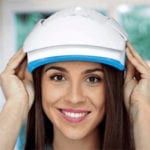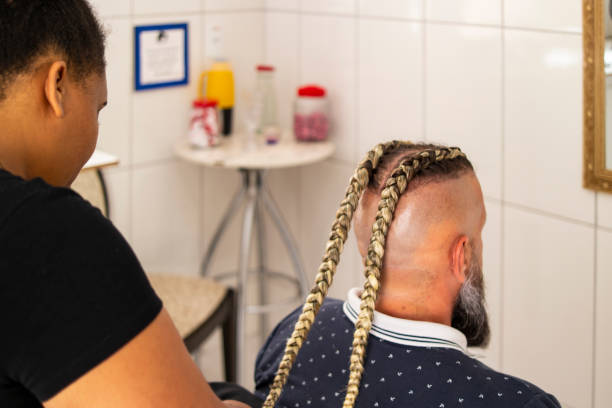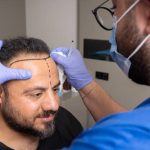July 3, 2023 By simonw Comments are Off
Table of Contents
Introduction to Traction Alopecia
What is Traction Alopecia?
The main cause of traction alopecia is the constant pulling or tension applied to the hair follicles. It commonly occurs due to certain hair styling practices that exert excessive strain on the scalp, leading to hair breakage and loss.
Understanding the Causes of Traction Alopecia
Traction alopecia is primarily caused by tight hairstyles, such as braids, buns, ponytails, dreadlocks, and hair extensions. The continuous tension applied to the hair follicles weakens them over time, resulting in hair loss. Factors such as repetitive styling, long-term use of protective styles, and glues or chemicals in hair extensions can contribute to the development of traction alopecia.

The Science Behind Traction Alopecia
The Link between Hair Styles and Traction Alopecia
Certain hairstyles, especially those that involve tight pulling or stretching of the hair, can lead to traction alopecia. The constant strain on the hair follicles disrupts their normal growth cycle and causes hair to become weaker and more prone to breakage.
Traction Alopecia and Gender Differences
Traction alopecia can affect both men and women, but it is more commonly observed in women due to their frequent use of tight hairstyles. However, men with certain hair styling practices, such as Sikh men wearing turbans, can also be susceptible to traction alopecia.
Symptoms of Traction Alopecia
Early Warning Signs
In the early stages, traction alopecia may manifest as a receding hairline, particularly along the side margins of the scalp or the front edges. Small hair loss or thinning areas may be noticed in the affected areas.
Advancement of Symptoms
Over time, traction alopecia can lead to the formation of bald patches in the affected areas, with hair loss potentially extending to other regions of the scalp. The hair near the edges of the scalp may become smaller and finer, while longer hairs are retained in the central area.
Prevention of Traction Alopecia
Safe Hair Styling Practices
To prevent traction alopecia, practicing safe hair styling techniques is important. Avoid hairstyles that involve excessive pulling, stretching, or tightness. Opt for looser styles, use gentle hair accessories, and give your hair regular breaks from tight hairstyles.
The Importance of Regular Breaks in Styling
Taking regular breaks from tight hairstyles allows the hair follicles to recover and reduces the risk of tension-induced hair loss. Alternate between different hairstyles and avoid continuously wearing the same tight style for long periods.
Diagnosis of Traction Alopecia
Medical Examination
A thorough scalp examination and a review of your hair care practices by a medical professional, such as a dermatologist or trichologist, are essential steps in diagnosing traction alopecia. They may ask about your hair styling routines, the duration of specific hairstyles, and any symptoms or concerns you have.
Diagnostic Tests
In certain instances, a biopsy may be conducted to confirm the diagnosis of traction alopecia. This involves taking a small sample of scalp tissue to examine under a microscope and determine the extent of hair follicle damage.
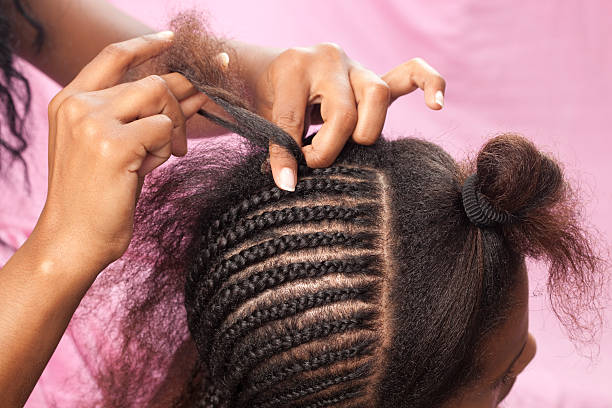
Treatment of Traction Alopecia
Medications and Topical Options
Topical minoxidil, a medication commonly used for other types of hair loss, may be prescribed to stimulate hair growth and improve the appearance of the affected areas. PRP (platelet-rich plasma) is another good non-surgical option that is taken from your blood.
Surgical Solutions for Traction Alopecia
In severe cases of traction alopecia where conservative treatments do not yield satisfactory results, surgical intervention may be considered. Follicular unit transplantation (FUT) or follicular unit extraction (FUE) are hair transplant techniques that can effectively restore hair in areas affected by permanent hair loss.
Living with Traction Alopecia
Psychological Impact and Coping Strategies
Living with traction alopecia can have a significant psychological impact, as it may affect one’s self-esteem and body image. Seeking emotional support from loved ones and considering counseling or therapy can be valuable in addressing negative emotions and anxiety related to the condition.
Support Groups and Helpful Resources
Joining support groups or online communities dedicated to hair loss can provide a sense of belonging and a platform to share experiences with others facing similar challenges. Additionally, various resources, including websites, books, and articles, offer valuable information and guidance on managing traction alopecia.
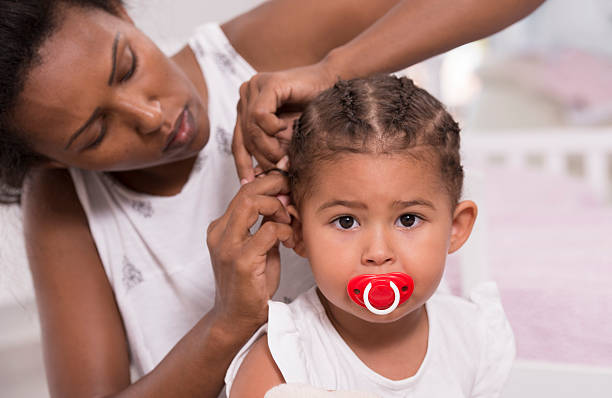
Q & A
What is the prevalence of traction alopecia in African-American women?
Traction alopecia is more common in African-American women due to the frequent use of hairstyles that exert tension on the hair, such as tight braids, ponytails, or extensions.
How does Afro-textured hair contribute to the development of traction alopecia?
Afro-textured hair is more fragile and prone to breakage, making it susceptible to traction alopecia. The tight pulling and manipulation of the hair in certain hairstyles can lead to the gradual weakening and eventual loss of hair.
Can traction alopecia be a form of alopecia areata?
Traction alopecia should not be confused with alopecia areata, as they are distinct conditions. The immune system’s attack on the hair follicles is the hallmark of alopecia areata, an autoimmune condition that results in hair loss. On the other hand, traction alopecia is caused by repetitive tension or pulling on the hair.
What is the American Academy of Dermatology's role in diagnosing and treating traction alopecia?
The American Academy of Dermatology provides guidelines and resources to dermatologists and healthcare professionals for diagnosing and treating various hair loss conditions, including traction alopecia. They promote best practices and evidence-based approaches to ensure optimal patient care.
What is the relationship between androgenetic alopecia and traction alopecia?
Androgenetic alopecia, commonly referred to as male or female pattern hair loss, is an inherited condition that leads to the progressive thinning of hair. While external factors like tight hairstyles cause traction alopecia, they can coexist with androgenetic alopecia and exacerbate hair loss in affected individuals.
Are ballerinas at a higher risk of developing traction alopecia?
Yes, ballerinas are at an increased risk of developing traction alopecia due to their tightly pulled-back hairstyles, such as buns or ponytails, which can exert constant tension on the hair follicles along the hairline and temporal scalp.
Can traction alopecia affects the beard area in men?
Yes, traction alopecia can affect the beard area in men who frequently engage in practices that cause repetitive tension on the hair follicles, such as pulling or twisting the beard excessively.
What is the best chance of recovery for individuals with traction alopecia?
The best chance of recovery for individuals with traction alopecia is to identify the condition early and make necessary changes to hairstyling practices, allowing the hair follicles to recover from the damage and promote hair regrowth.
What is the best treatment for traction alopecia?
The best treatment for traction alopecia is to remove the source of tension or pulling on the hair and adopt hairstyles that do not stress the hair follicles excessively. In some cases, medical treatments such as topical steroids or surgical interventions may be considered.
How can a board-certified dermatologist help diagnose and treat traction alopecia?
A board-certified dermatologist has the expertise to diagnose and treat traction alopecia accurately. They can evaluate the scalp, identify the underlying causes, provide appropriate medical treatments or refer patients for surgical interventions when necessary.
What leads to hair loss in traction alopecia?
The cause of hair loss in traction alopecia is the repeated tension or pulling on the hair, leading to hair follicles damage. This damage disrupts the hair growth cycle and eventually results in hair loss.
What is the association between iron deficiency and traction alopecia?
Iron deficiency is not directly associated with traction alopecia. However, iron deficiency can lead to general hair loss and thinning, which may exacerbate the effects of traction alopecia. Addressing any underlying nutritional deficiencies to support overall hair health is important.
Are Japanese women more prone to developing traction alopecia?
Japanese women may be more prone to traction alopecia due to certain traditional hairstyles involving tight braids or hairstyles that strain the hair follicles. However, the prevalence of traction alopecia can vary among individuals within any ethnic group.
Can traction alopecia affect the temples and side margins of the scalp?
Yes, traction alopecia can affect the temples and side margins of the scalp, especially when tight hairstyles or hair extensions are worn consistently in those areas.
Are there specific treatment options for children with traction alopecia?
The treatment options for children with traction alopecia are similar to those for adults, including avoiding tight hairstyles, implementing gentle hair care practices, and ensuring a nutrient-rich diet. However, consulting with a pediatric dermatologist for appropriate guidance is important.
Can repetitive tension from tight hairstyles cause permanent damage in severe cases of traction alopecia?
Yes, in severe cases of traction alopecia where the hair follicles have been subjected to prolonged and excessive tension, it is possible to experience permanent damage to the hair follicles, leading to irreversible hair loss.
What is the role of topical steroids in treating traction alopecia?
A dermatologist can prescribe topical steroids to reduce inflammation and promote hair regrowth in the affected areas of traction alopecia. They help to soothe the scalp and encourage the healing process.
Can stress contribute to the development of traction alopecia?
While stress may not directly cause traction alopecia, it can lead to certain hair care practices, such as tight hairstyles or hair pulling, increasing the risk of developing traction alopecia.
What are the recommended hairstyles for individuals with a history of traction alopecia?
Individuals with a history of traction alopecia are advised to opt for loose, less tension-inducing hairstyles. This may include wearing the hair down, using gentle hair accessories, or choosing protective styles that do not pull tightly on the hair.
How can support groups and helpful resources assist individuals with traction alopecia?
Support groups and helpful resources provide a platform for individuals with traction alopecia to connect, share experiences, and gain emotional support. They may offer guidance on coping strategies, hair care tips, and the latest advancements in treatment options.
What role do education and awareness play in reducing the prevalence of traction alopecia?
Education and awareness are crucial in reducing the prevalence of traction alopecia by promoting knowledge about the condition, its causes, and preventative measures. Individuals can make informed choices and protect their hair health by understanding the risks associated with certain hair care practices.
Is central centrifugal cicatricial alopecia related to traction alopecia?
Central centrifugal cicatricial alopecia (CCCA) is a form of hair loss that primarily affects women of African descent. While CCCA shares some similarities with traction alopecia, it is a distinct condition characterized by hair loss that starts at the central area of the scalp and spreads outward.
Can traction alopecia cause the development of bald patches?
If left untreated, traction alopecia can lead to bald patches in the areas of the scalp that have been consistently subjected to tension. This occurs due to the weakening and damage of the hair follicles over time.
Conclusion: Reducing the Risk of Traction Alopecia
Making Informed Choices about Hair Styling
By understanding the causes and potential risks of traction alopecia, individuals can make informed choices regarding their hair styling practices. Opting for looser hairstyles, avoiding excessive tension or pulling, and taking regular breaks can help reduce the risk of developing traction alopecia.
The Role of Education and Awareness
Education and awareness about traction alopecia are crucial in preventing and managing the condition. By spreading knowledge about the potential dangers of certain hair styling practices and promoting safe alternatives, we can help individuals maintain healthier hair and scalp.
Comments are closed.





